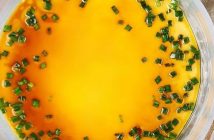 Most people will say the best thing about living in Beijing is the food. Although to be honest, with the traffic jams and the pollution, there’s hardly competition. But
Most people will say the best thing about living in Beijing is the food. Although to be honest, with the traffic jams and the pollution, there’s hardly competition. But
when most people talk about the food, they mean restaurant food, which no one can argue with. From chewy Shanxi noodles to the kick and tingles of Sichuan spice, the excellent selection of regional Chinese food in Beijing is unparalleled.
Choices in fresh and dried produce Beijing are undervalued and deserve reimagining by a discerning and innovative eye – at least that’s what I’ve always thought and aspired to highlight in these monthly columns. I can’t say that I’ve always been successful, but I certainly hope it’s been entertaining to read my recipes and try them out.
As I leave Beijing this month, this will be my last column. I hope I’m leaving behind readers who are more curious and engaged in cooking with Chinese ingredients than they otherwise would be. Yes, you can make soup with cans of
imported Swansons, but what about simmering your own stock? Sure, escarole is hard to find, but what about a salad with baby Napa cabbage and Sichuan peppercorn dressing? And I hope someone out there switched up their breakfast with a bowl of pumpkin and coconut congee.
Using Chinese ingredients to substitute Western ingredients in Western recipes isn’t hard: beans for beans, peppers for peppers. If you ever fi nd yourself looking at an unfamiliar vegetable, you can always try it out with the simplest cooking technique there is. Oil at the bottom of a hot wok, when it’s smoking, throw in some minced green onion and ginger, stir it around for a few seconds, and then add whatever you just chopped right in, cook until it wilts or becomes tender. Add a bit of salt on the way out of the pan. This, after all, is the Chinese version of learning to boil water. Okay, okay, you got me. The Chinese version of learning to boil water is still boiling water, but when you want to boil or steam something, try it stir fried instead. The more you do it, the more you’ll feel confi dent enough to drizzle a little bit of soy sauce, sesame oil or chilli paste in at the end. Everything begins from there.
Numbing Salad
Serves 2 for dinner or 4 for side dishes
2 tbsp peanut oil
½ tsp Sichuan peppercorns
2 tbsp rice vinegar
1 tbsp sesame oil
1 tsp fish sauce
2 tsp sugar
2 heads of baby Napa cabbage, or wawacai (Chinese for baby greens)
1 small red onion
1 chicken breast, cooked and cut into strips
1 bunch cilantro, cut into 1 inch stalks
1 tbsp toasted sesame seeds
In a pan, heat peanut oil until just smoking. Place peppercorns in a heatproof bowl, and poor hot oil over the peppercorns. Let the oil rest until it cools. Strain or pick out the peppers. Add vinegar, sesame oil, fi sh sauce and sugar to the oil. Whisk until blended. Add salt if necessary, but note that the fish sauce will be very salty. Stack the cabbage leaves and chop them across the grain into strips. Slice the onion into strips. Toss the onion, chicken, cabbage, cilantro with the dressing. Sprinkle with sesame seeds.
This article is excerpted from beijingkids August 2011 issue. View it in PDF form here or contact distribution@beijing-kids.com to find out where you can pick up your free copy.



